Kit Nagamura/Sarah NishinaJournalist, Writer / Tour Guide, Consultant
Recommend Tour08
Kit Nagamura/Sarah NishinaJournalist, Writer / Tour Guide, Consultant
Recommend Tour08
A trip to Echizen City for people of various backgrounds to experience the city's climate.The two women who will be touring Echizen City this time are Kit Pancoast Nagamura from the U.S. and Sarah Nishina from Australia.Kit and Sara, who have been in Japan for about 30 years, have visited all over Japan as writers and journalists, covering the charms of the local climate and craftsmanship.
.jpg) Left:Kit Pancoast Nagamura
Left:Kit Pancoast Nagamura
Rgiht:Sarah Nishina
Kit has lived in Tokyo since 1991 and has worked as a journalist and writer.She has contributed a column titled “The Backstreet Stories” to The Japan Times since 2008.Sarah has also lived in Japan since she came of age.She is a writer, tour guide, consultant, and has many layers and well versed in Japanese culture.They have visited Fukui Prefecture in the past, but this was their first visit to Echizen City.This time, we will closely follow the two of them on their interview trip.
We first came to Kyomachi 1st Street, the central district of Echizen City, where many buildings from the Taisho era still remain.On "Teramachi-dori", a stone-paved street, you will find “Urushiya", a long-established buckwheat noodle shop that is the "birthplace of Echizen soba"
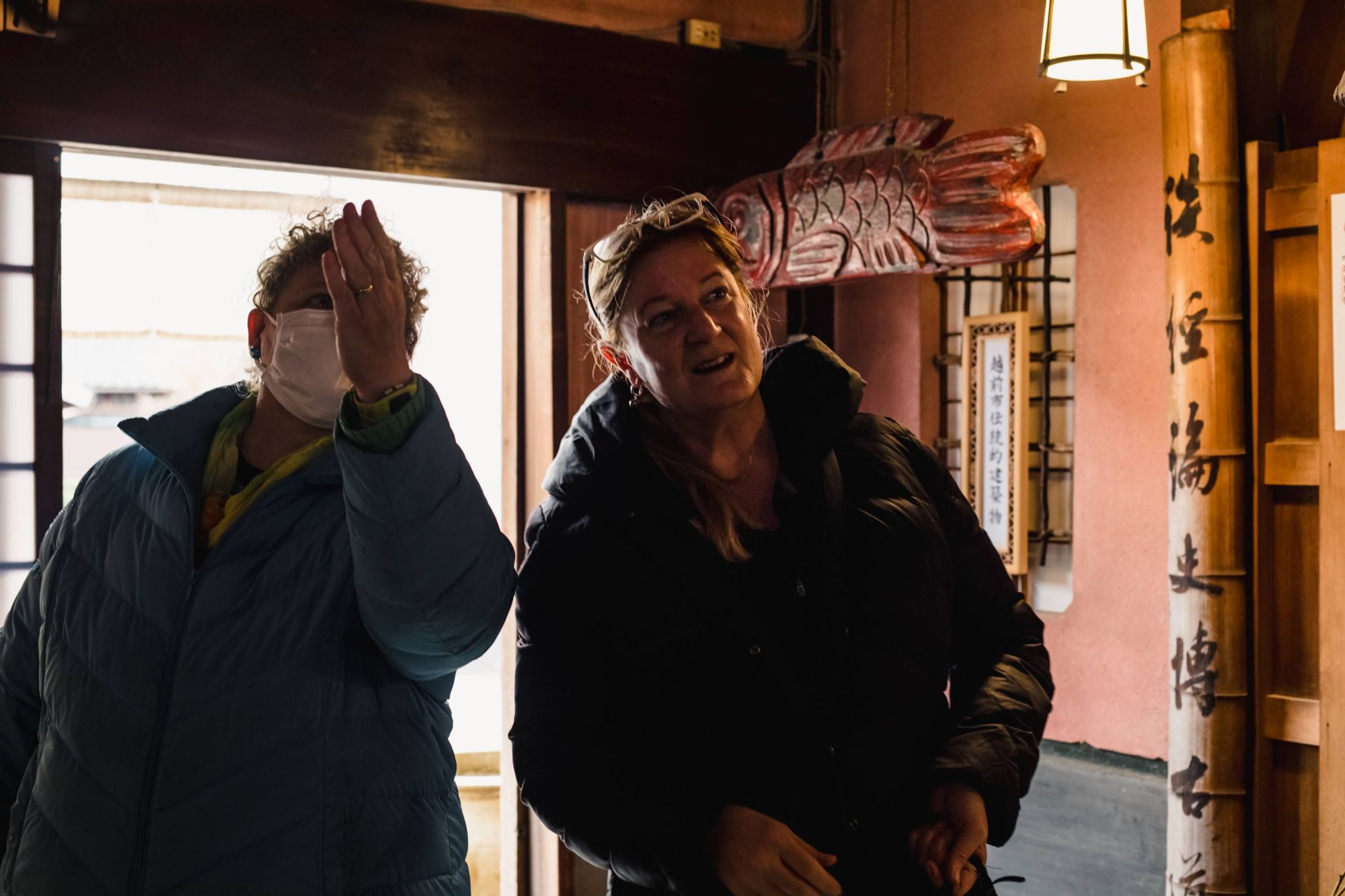
Urushiya was founded in the late Edo period.The store, as its name suggests, was once engaged in the sale of lacquer and was reborn as a buckwheat noodle shop in 1861.Perhaps a remnant of its past as a lacquer merchant, the store's pillars and beams are coated with lacquer, and the tsuboniwa garden and furnishings are faithfully preserved as they once were.
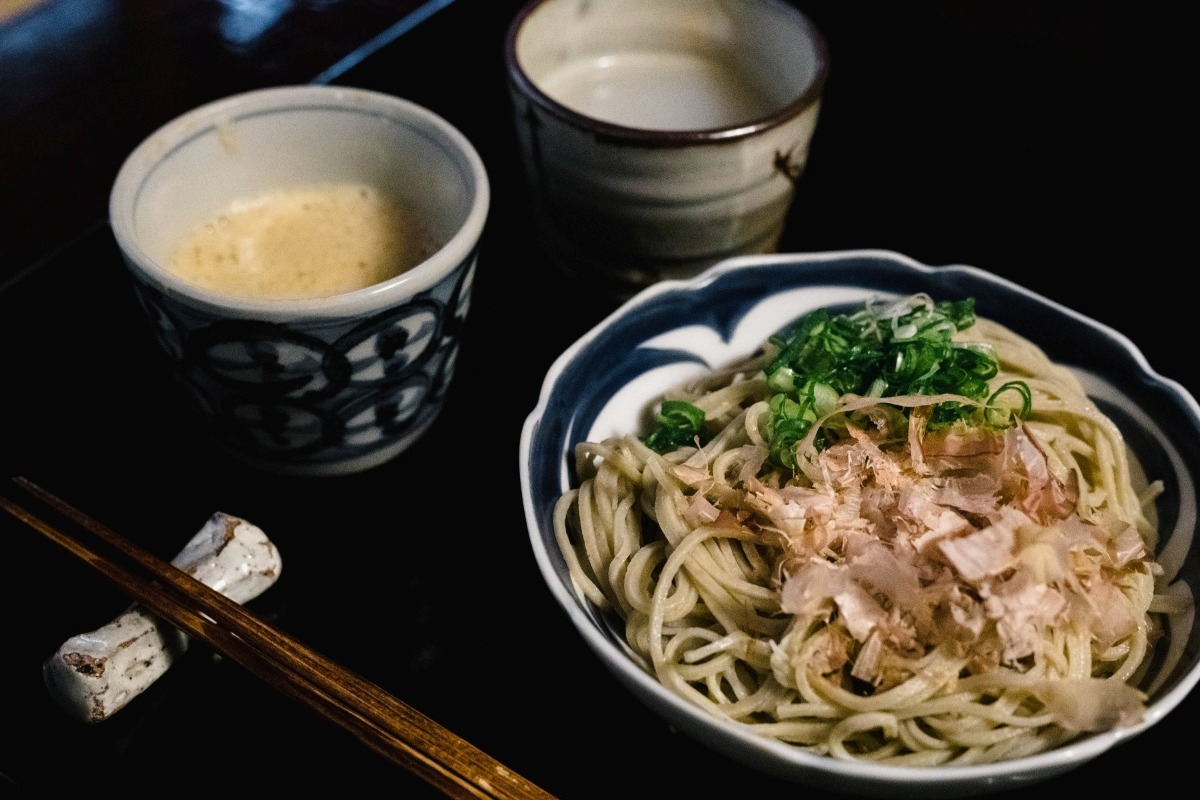
One of the most famous episodes in Urushiya's history occurred in 1947, when Emperor Showa visited Takefu.Emperor Showa was so pleased with the grated soba that he fondly remembered it after returning to the palace, saying, “That Echizen soba….”It is said that the name “Echizen soba” spread from here.The soba is a type of green tea soba with matcha green tea kneaded into it, and is dipped in a dipping sauce made from a mixture of squeezed daikon radish juice and soy sauce. The grated buckwheat noodles, recreated based on the stories of people who knew the area well and the few documents available at the time, are served as “Nadai grated buckwheat noodles”.
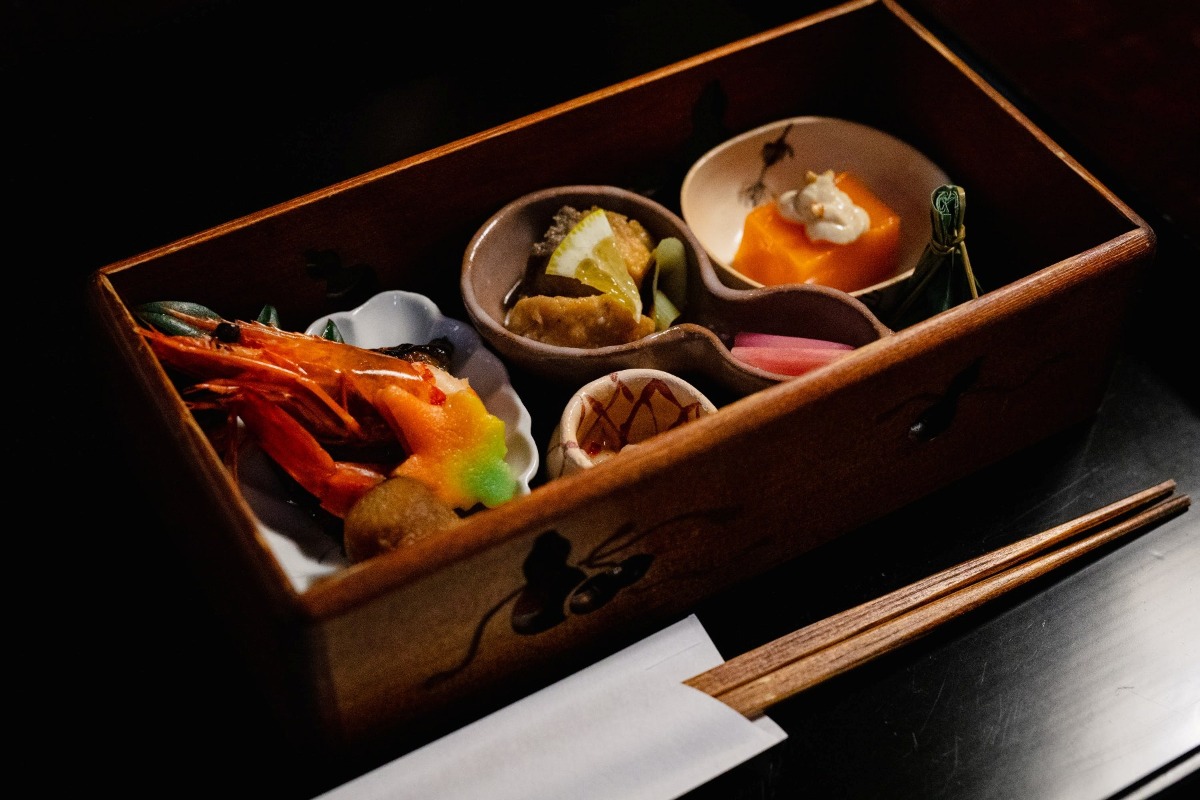
"Urushiya” is also popular for its kaiseki meals that include soba as part of the course.
Kit and Sarah cheered as the six gourd box with its beautifully arranged appetizers appeared.
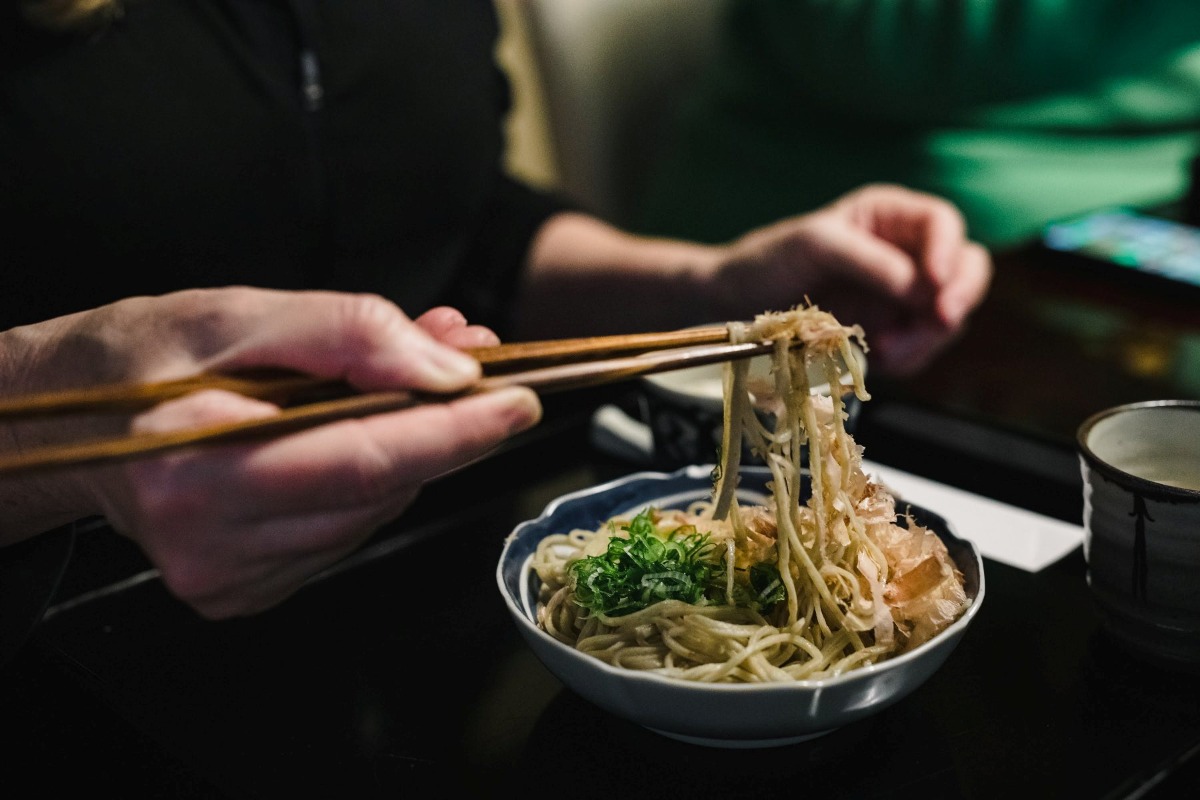
Kit has eaten soba all over Japan, but she was surprised by the punchy flavor of the spicy daikon.
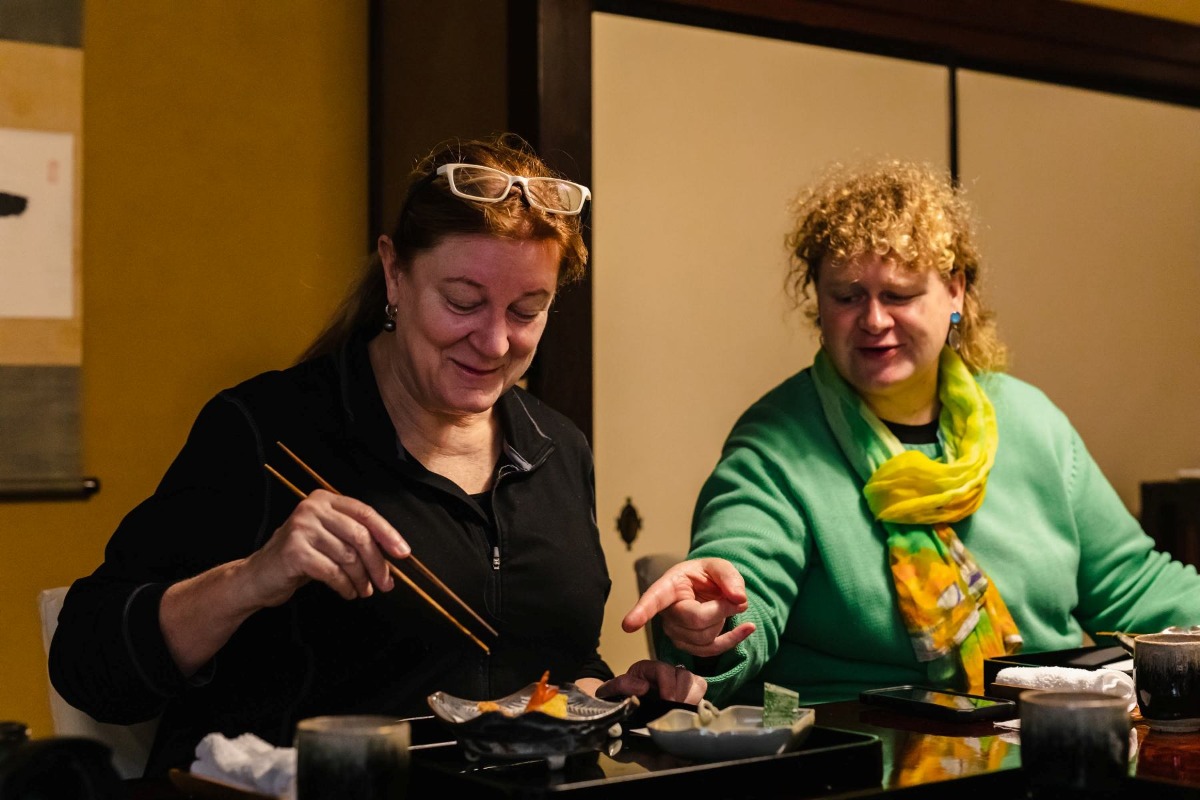
This time, we were served in a private room where Emperor Showa dined.
"It's such a rare experience to eat Japanese soul food in a place associated with the Showa Emperor!" Sarah was also excited.
After enjoying a variety of kaiseki cuisine, including buckwheat noodles, mackerel sushi, and tempura, we will head to our next destination.
It takes about 10 minutes to walk from JR Takefu Station.
Next, we visited “Mido Yougan-ji Temple,” which has a distinctive presence in Takefu, a town with many temples dating back to ancient times.
.jpg)
Yōgan-ji Temple was built in the Muromachi period (1333-1573) and is also known as “Mido” or “Gobo,” a prestigious temple.The palace and the meeting place on the temple grounds were built to welcome the Gomonshū a.k.a chief priest of Nishi Honganji, the head temple of the Honganji sect of Jōdo Shinshu.Stepping into the austere space, the air is dignified.
.jpg)
In addition, the “Goten Garden,” which stretches to the south of the a 230 tubo* temple garden, is so beautiful that it will leave you gasping for breath.The panoramic view from the palace gives a sense of openness, and the azaleas, azaleas, autumn leaves, and other beautifully arranged plantings make you want to forget about the time and gaze at them forever.
.jpg)
The man who showed them around was Hijiri Fujieda, the chief priest of the temple.
In an effort to make Yoganji, which is located in the city center but until now has only been visited by followers, more open to the public, a variety of events are being planned, including special visits, a temple café, and concerts.
.jpg)
The priest led us further into the garden of the palace.This time, the Japanese style is completely changed to a retro reception space.
This is a reproduction of a room in the auditorium of the University of Paris, France, where the 14th head priest studied for eight years from 1882.With its plastered ceilings and ceramic lighting, which is rare nowadays, the space seems as if you have stepped back in time.
.jpg)
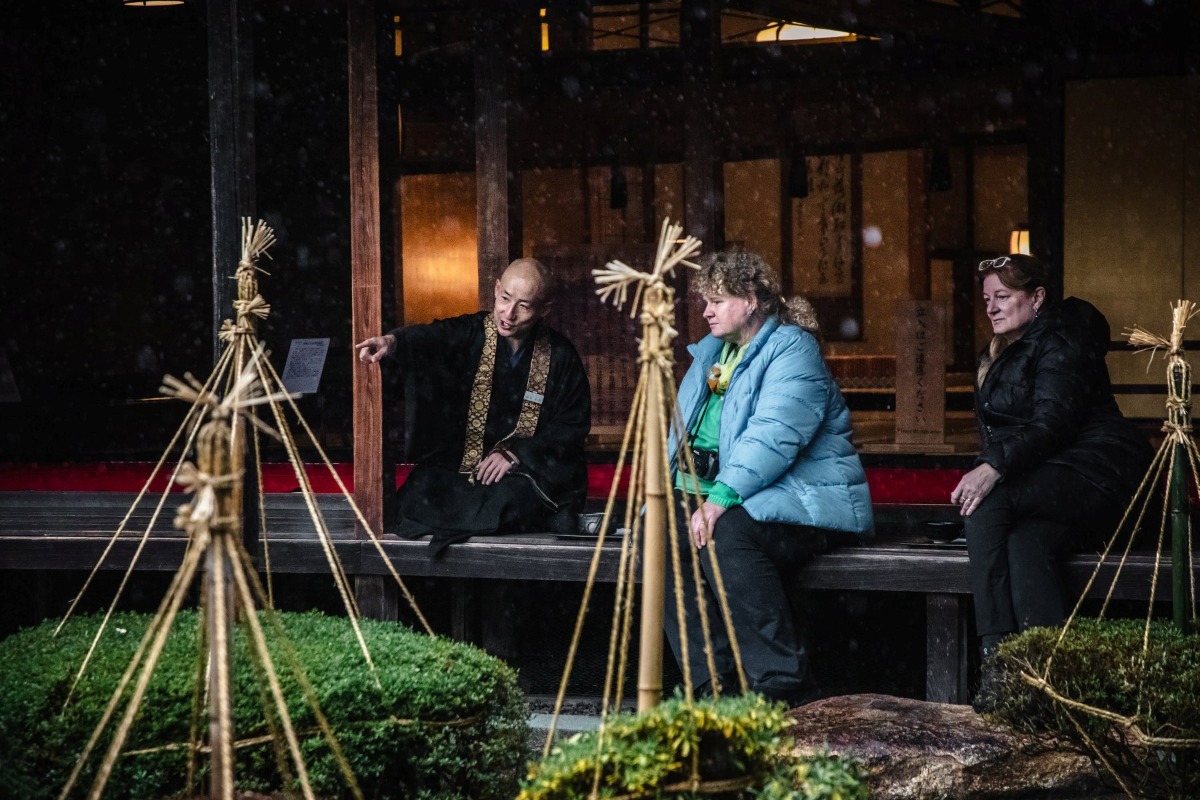
We can savor the moment of enjoying matcha green tea and sweets inspired by Yoganji's theme colors while admiring the garden.The conversation with the priest was endless, and their enthusiastic interview continued until time permitted.
tubo* = Onetubo measures approximately 3.3 square meters.
.jpg)
After leaving Yoganji, the next stop was the long-established cutlery store “Kirin Cutlery".
The impressive giraffe symbol displayed in front of the workshop is a landmark.
.jpg)
Kirin Cutlery was founded in 1872 and has been in business for five generations.Yasutaka Iida, the owner of the workshops, recounts the time when the workshop was established.
"At the time, the craftsmen stamped their own sickles.Most of them with animal engraving.One of the craftsmen happened to have struck the giraffe as a fictional Chinese animal, so we registered the trademark.Giraffe is famous for its beer, but at that time, it could be utilized in a different industry.That's why we still mark our knives with the giraffe symbol.”
.jpg)
Echizen hammered blades, one of Echizen City's proud traditional crafts, were brought to the city by Chiyotsuru Kuniyasu, a swordsmith from Kyoto, during the Nanbokucho Period.According to Mr. Iida, there are three reasons why Echizen City has become a production center of cutlery.
“The first reason is that the Hino River, which flows through the Hakusan Mountains, provides a source of water necessary for blacksmithing,Second, there was iron-rich soil that was resistant to heat,And the third reason was the abundance of wood from which to make charcoal.”
.jpg)
One of the most eye-catching features of the Kirin Cutlery workshop is a large painting that covers the entire wall.This drawing of a Kirin cutlery workshop was made by a local elementary school student nearly 70 years ago.
“This area used to be a blacksmith town.The river that existed at that time and the rows of pine trees are also depicted.In the old days, the bell of a nearby temple would ring at two o'clock in the morning, and that was the signal for the blacksmiths to get up.”
.jpg)
We were also shown the warehouse at the back of the workshop, where the blades are stored.Since the blades are made of metal, the blades need time to lay down in order to stabilize the molecules.
The age-old tools still in use today are a testament to the history of Kirin cutlery.Learning about the background of Echizen hammered blades, Kit and Sara further deepened their understanding of the region.
After a three-minute walk from the kirin cutlery, the next destination came into view.
We arrived at kicoru, an atelier opened in 2014 by Oyanagi Tansu, a long-established Echizen tansu (chest of drawers) maker.
Using traditional sashimono techniques, the shop displays and sells a variety of pieces, including custom-made furniture and speakers made in collaboration with designers.
.jpg)
Originally, craftsmen who made furniture were called “sashimono-shi,” which is derived from the term “measuring,” which means to work with a “ a ruler” and assemble lumber by means of tenon or joints
Around the middle of the Meiji period, full-fledged tansu craftsmen became active.Even today, Echizen City still has a tansu town street, lined with fixture merchants and furniture stores.
.jpg)
"Echizen tansu is made from a combination of three Echizen techniques: a unique technique of joining wood to wood, metal fittings made from hammered blades technique, and lacquer coating to protect the wood and strengthen the tansu,” said Norikazu Oyanagi, the fourth generation of Oyanagi Tansu.
Echizen tansu is a traditional craft that was born in Echizen City, a place where various manufacturing areas such as Echizen hammered blades and Echizen lacquerware are concentrated within a 10-kilometer radius around Echizen City.
.jpg)
The heart-shaped pattern seen on the metal fittings is one of the characteristics of Echizen chests, and is called “Inome”.They were meant to ward off fire and were used on the gates of Horyuji Temple and other shrines and temples. These metal fittings are sanded and prepared by hand.
.jpg)
The metal fittings that make a distinctive sound when the key is opened are also a device that has been handed down from generation to generation.
Both Kit and Sarah are observing with great interest.
.jpg)
The tour also included an interview on how karakuri chests are made and a hands-on experience with the planing a piece of lumber and it was a fulfilling interview.
The first day's coverage has come to a close.In the evening, we arrived at the area commonly known as “Kuranotsuji,” lined with white-walled warehouses to taste the gourmet food of Echizen.We arrived at “Japanese Cuisine Shikura."The highlight is “Echizen crab dishes,” which are considered the king of Echizen's winter.
.jpg)
"Echizen crab” is a male snow crab that is landed at a port in Fukui Prefecture. The Sea of Japan along the Fukui coast has many fishing grounds where warm and cold currents collide, and the plankton that feeds the crabs is abundant, so the crabs grow to be large and full of flavorful meat.
The fishing season opens on November 6 every year.Until the end of the fishing season, which ends on March 20 of the following year, the course menu will be replaced by a single Echizen crab dish.
.jpg)
They were surprised at the size of the boiled crab brought in by the owner and said, “WOW!
The moist, chewy meat and rich miso will delight their taste buds.
.jpg)
Female snow crabs, called “seikogani,” are also popular among the locals.The fishing season here is shorter than in Echizen-crab, lasting until the end of December, and the roe, called uchiko (inner roe) and sotoko (outer roe), is superb.
.jpg)
The best part of the meal is the “Kora Sake,” which is sake poured into the crab's shell.
The flavor of the crab and the mellow aroma of sake make the sake going down smoothly.
.jpg)
A delicious meal and delicious drinks served while reflecting on today's journey.
Thus, the night in Echizen was passing.
This is the second day of the interview trip.On this day, we will move to the Imadate district, a production area of Echizen Washi paper, to continue our coverage.We came to “Yanase Washi”.We mainly make plain and patterned “fusumagami” (sliding door paper) using the “nagashizuki” technique.
.jpg)
.jpg)
Kit and Sara experienced one of the traditional techniques of Echizen washi, “Hikkakke".This is a technique unique to Echizen washi developed after World War II, in which A3-size washi is made and patterns are created by “hooking” the raw materials of the washi into a special mold.
.jpg)
“I've done papermaking a few times,” Kit says.Beautiful patterns emerged with a skilled hand.While the washi is drying, Haruo Yanase, the second generation owner of Yanase Washi, will talk about the charm of Echizen washi.
.jpg)
"Echizen Washi is a traditional Japanese paper production area that has always responded to customer requests as much as possible.We have also accepted requests for patterns that we have never done before ,and we don't know if we can do, from postcard-sized paper to sliding door paper that takes two people to make.We've developed our skills and know-how through experience, with the spirit of trying things out first.”
Along with Haruo, Sho is the third generation to help out in the family business.
After graduating from National Institute of Technology, Fukui College, he entered the family business and succeeded to Haruo's skills as his successor.
"At first I found it difficult to do the work my parents were doing without any difficulty, but now I am able to move much more naturally.My father and I were the only two men on the team.In addition to our main business of fusuma paper, we are also developing new washi products, such as washi boxes, to expand the possibilities of washi.”
.jpg)
A father thinking of his son and a son following his father's back.
The warm relationship between parent and child made both Kit and Sarah smile.
The last place we visited was the Iwano Heizaburo Paper Mills, also in the Imadate area.Founded in 1865, it is the largest workshop for handmade Japanese washi in Japan.
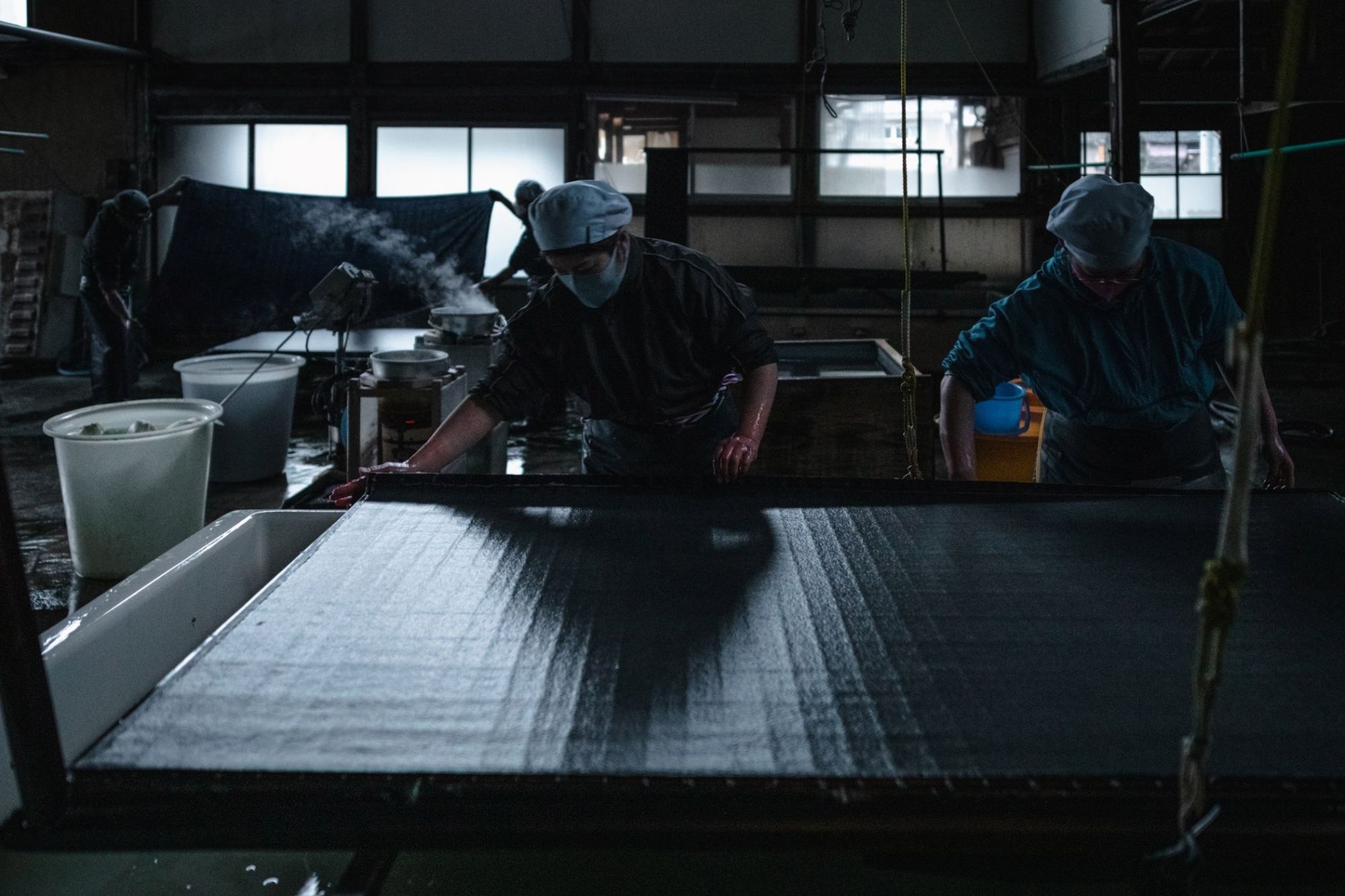
"Kumohadamashi” is an epoch-making washi that Heizaburo Iwano I revived in 1926 after researching hemp paper, which had once been discontinued.
At the time, Japanese painting was mainly done on silk canvas, but the advent of Kumohadamashi, a strong paper that could be overlaid with paint, revolutionized the Japanese painting world.It has been loved by numerous artists, including Taikan Yokoyama and Ikuo Hirayama, and has been used in some of Japan's most famous cultural properties, including the restoration of the mural paintings in the Golden Hall of Horyuji Temple and the sliding door paintings at Toshodaiji Temple.
.jpg)
Before high-quality washi is made, the “yori” (selection) process is indispensable.
Female staff members put their hands in the cold water, even in the middle of winter, and remove the dust one by one.
.jpg)
The dust is so slight that you have to strain your eyes to see it.The process of sorting by eye and touch alone is the product of many years of experience.
.jpg)
Iwano Heizaburo Paper Mills is characterized by its technique of making large sheets of paper.The paper is made in pairs, or for large sheets of paper, in groups of four or six.Performing each movement in unison with your breath is unintentionally breathtaking.
.jpg)
After several layers of washi have been made, they are placed on a jack and pressed.The layers of paper are then peeled off one by one, attached to boards, and put through a room drying process in a warm room.
.jpg)
Handmade Japanese paper is pasted on a gingko board.The smooth texture with few knots is said to create a soft and beautiful pattern.
Washi made by Iwano Heizaburo Paper Mills is produced on a dynamic scale while retaining the delicacy of handmade paper.With their intellectual curiosity and their interest piqued , Kit and Sarah had a lively conversation with the artisans.
.jpg)
After two days of touring Echizen's manufacturing sites, we finally asked them about their impressions of the trip.
“Until I visited Echizen in winter, I had the impression of gray skies.But when I actually toured the town, I felt the warmth of the craftsmanship and the people involved in it, and had a wonderful time.I would like to go back to the places I couldn't go this time,” said Sara.
"I knew there was a wonderful craftsmanship in Echizen, but actually visiting the workshop made me happy to see that 'it really existed!' Perhaps we will have more special memories if you visit with a small group of people rather than a large group, because you will have more intense contact with the people,” Kit continues.
.jpg)
.jpg)
.jpg)
For Kit and Sarah, who are well versed in Japanese culture, this trip was a time to fully experience the charms of Echizen City.
I was impressed by Kit's words, “There are many people who want to come to Echizen."
Text/Ai Ishihara